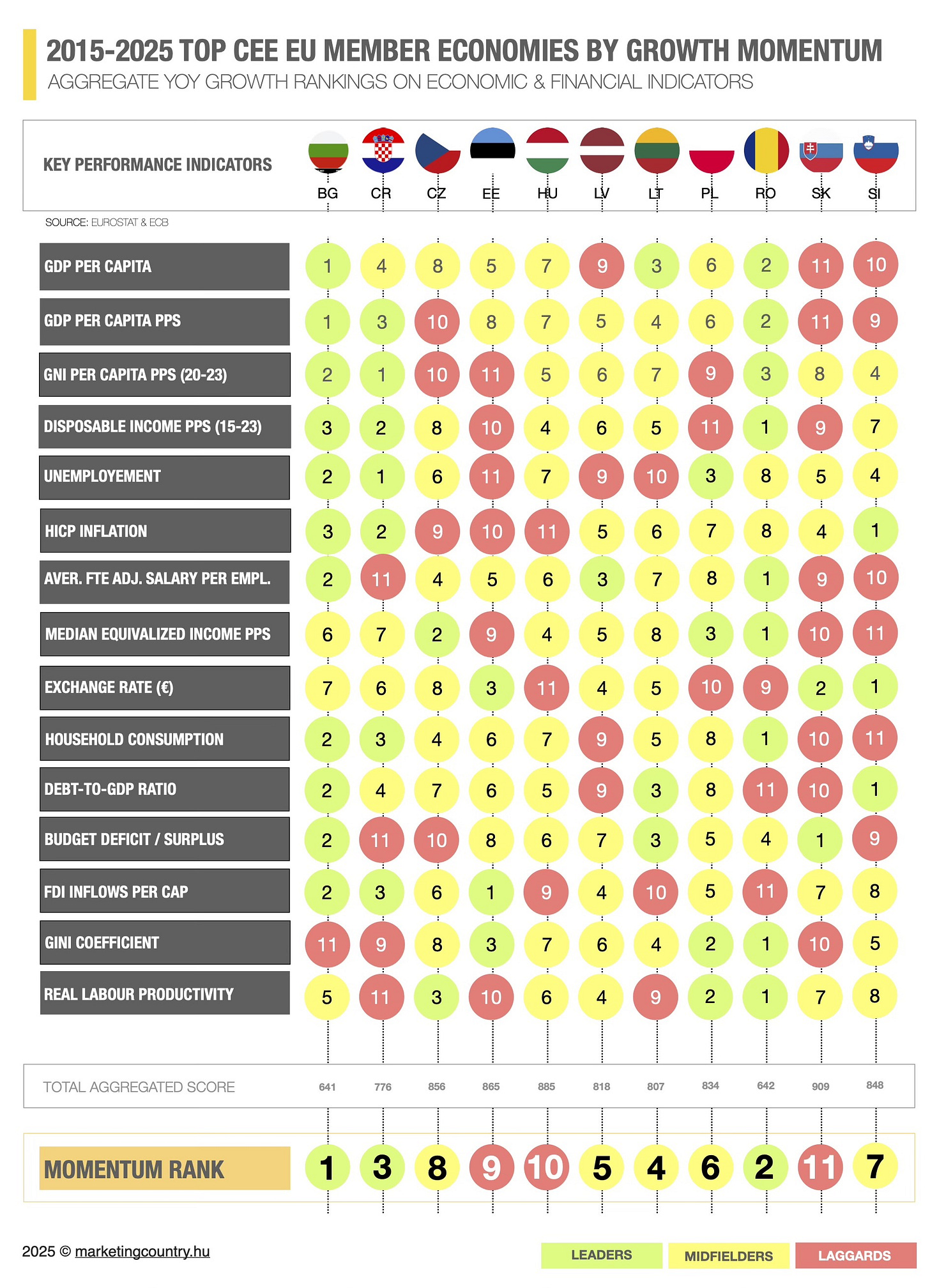Would You Red Card Your CEO?
Beyond Stability — Benchmarking Orbán’s Government Against Its Regional Peers

Growth rates are the trendlines of governance and indicators of momentum. By focusing on annual changes rather than absolute levels, they strip away inherited advantages and reveal whether leaders are truly moving their country forward—and how quickly. Hungary’s decade-long record shows a clear pattern of declining competitiveness: respectable in some years, but consistently outpaced by peers, leaving it entrenched near the bottom of the regional league table.
The Great Illusion: Political Stability Does Not Necessary Mean Economic Performance
Imagine your country as a publicly listed company. Citizens are the shareholders, the Prime Minister is the CEO, Parliament approves the strategy, and auditors—statistical offices, Eurostat, the ECB—publish the accounts. Elections are the annual general meetings where contracts are renewed—or terminated. (And yes, every four years is far too infrequent—which is why, in my essay on rebuilding accountability in public office, I argued for more frequent and enforceable mechanisms of accountability.)
In theory, this is democracy. In practice, most citizens evaluate their CEO the way amateur investors judge companies: by scanning one big, shiny number. GDP growth is the favorite headline—politics’ equivalent of a CEO boasting, “Revenue up 5%!” The problem is that reality, like financial markets, doesn’t reward a single number. It rewards sustainable, balanced, peer-beating performance.
No investor would be satisfied with a CEO announcing, “Revenue grew 5%” while competitors delivered 7–10%, margins collapsed, and the product pipeline ran dry. Yet in politics, governments often get away with exactly this trick—especially when there is no competent opposition or an independent media willing to play watchdog.
Hungary is a perfect case. Between 2015 and 2024 it had the most stable government in the region: an uninterrupted CEO (Viktor Orbán), full control of the boardroom (supermajority), and no shareholder revolts. Political stability should have been a competitive advantage: continuity, long-term planning, credibility. It was constantly presented as one.
But the peer-comparison scorecard tells a different story. Across the decade, on economic and financial year-on-year growth rates—the momentum, the trendlines of governance—Hungary’s CEO delivered one of the weakest performances among regional peers. Stability hardened into complacency, and complacency produced chronic underperformance.
That is the illusion. This essay argues for breaking it.
Citizens should act like activist shareholders: benchmarking government performance against peers, measuring not only growth but also stability, discipline, and resilience—and issuing a red card to underperforming CEOs, no matter how glossy their annual letters look.
Hungary Inc.: Turning Statistics Into a Shareholder Report
The logic is simple: you don’t judge a company on one quarter’s revenue, but on consistent performance against peers. The same principle applies to governments.
Between 2015 and 2024, eleven Central and Eastern European (CEE) and Baltic economies—Bulgaria, Croatia, Czechia, Estonia, Hungary, Latvia, Lithuania, Poland, Romania, Slovakia, and Slovenia—competed on the same pitch.
Fifteen economic and financial KPIs were tracked annually (Eurostat, ECB). These included GDP growth, GDP per capita, productivity, disposable income, inflation, debt, deficits, employment, wage growth, the current account, and others.
For every indicator, the year-on-year growth rate was calculated—2016 vs 2015, 2017 vs 2016, and so on—to capture direction and momentum. Each year, countries were ranked from first (score = 1) to last (score = 11). For “lower is better” indicators, such as inflation and debt, scores were inverted so that discipline was rewarded. Annual scores were then summed and aggregated across the decade. The lower the total, the stronger the performance.
This produces a robust dataset covering ten years—long enough to filter out one-off shocks and reveal enduring trends.
Crucially, it punishes selective storytelling.
You cannot trumpet GDP growth if inflation wipes out real incomes, debt piles up, or productivity stagnates. You cannot boast about wages if median income in PPS lags peers. Success comes only from broad, consistent improvement.
The results?
Hungarian Government Economic Momentum Scorecard: Yearly Gains, Decade-Long Underperformance versus Peers
Over the decade, on momentum (growth rates), Hungary ranked 10th out of 11—ahead only of Slovakia. Bulgaria, Romania, and Croatia formed the top tier; Lithuania, Latvia, Poland, Slovenia, and Czechia anchored the midfield; while Estonia, Hungary, and Slovakia trailed as laggards. Momentum, after all, is the trendline of real performance.
If this were a corporate peer review, Hungary Inc. would be a laggard stock—not bankrupt, but chronically underperforming its sector.
Hungary’s position was not based on cherry-picked numbers or on “bashing Orbán” emotional narratives, but on year-on-year growth across key indicators: GDP per capita, disposable income, wages, labour productivity, inflation, debt, fiscal balance, exchange rates, FDI, consumption, and inequality1. Each year, every country was ranked from best to worst. Hungary did not break into the top tier on any of them.
Some years looked decent in isolation. But compared with peers, Hungary was consistently outpaced.
Its record was not one of collapse but of lagging momentum—others simply advanced faster.
The fundamentals told the story citizens lived daily. Disposable income held up relatively well compared to neighbors, but at the expense of household consumption, dampening demand and economic vitality. Repeated inflation spikes destroyed the real value of wage gains. The forint’s weakness against the euro added another layer of erosion, making travel, imports, and savings more expensive. Families saw that even as wages rose on paper for some, median wages declined in real terms—and real purchasing power slipped further behind.
Volatility punished the overall score. Economies that avoided wild swings steadily climbed the table. Hungary stumbled with repeated “yellow cards”: inflation shocks, fiscal swings, inconsistent income growth. For investors, volatility destroys trust; for citizens, it creates daily insecurity—whether their paycheck will stretch or their savings will hold value.
One fact sets Hungary apart: it had the most stable government in the region from 2015 to 2024. While most countries saw contentious changes, Hungary kept a single management team in place. In corporate terms: a CEO with full control, uninterrupted tenure, no shareholder revolts. That stability should have been an advantage—continuity of strategy, long-term planning, investor confidence.
Instead, relative performance across ten years of year-on-year growth rates left Hungary at the bottom of the momentum league. Stability did not translate into efficiency, productivity, or future readiness. It calcified into complacency.
If the country were a listed firm, analysts would conclude: “Revenue growth positive, but balance sheet weak; margins eroded by inflation; volatility risk elevated.” In other words: a sell recommendation, not a buy.
The Unfulfilled Role of Shareholders
In capital markets, CEOs cannot hide for long: analysts, rating agencies, and financial media publish comparisons that strip away spin. If a company trails its sector, investors know it.
Opposition parties, the supposed shareholders, rarely translated Eurostat and ECB tables into narratives ordinary citizens could grasp. Facebook likes mattered more. They failed to apply pressure, failed to offer credible solutions, and remain stuck on the “bitching lane” of politics. Nobody explains how they would outperform the government—what they would build better.
Independent media, another set of shareholders, reported individual statistics but seldom built comparative, holistic stories about the economy. They were politically critical of the government, but largely silent on its real economic anomalies. Instead, they leaned on emotional narratives that deepened polarization.
In ten years, neither opposition nor media effectively challenged the government’s narrative. Even now, as economic and social pressures create a growing pool of potential protest voters, the alternative CEO and board have no clue how they would address the country’s challenges.
Citizens—the real shareholders—were given banners (“5% growth!”) instead of scoreboards (“10th of 11 over the decade”). Without opposition or media pressure, complacency flourished. The CEO stayed in place despite chronic underperformance.
If citizens acted like activist shareholders, they would demand the same discipline markets demand: benchmarking against peers, consistent execution, and clear strategic direction. They would ask whether Hungary grew faster than Bulgaria, Romania, and Poland; kept debt lower than Slovenia and Czechia; innovated like Estonia and Lithuania; and raised median incomes above inflation. The scorecard answers no.
Remaining in the business metaphor, the investor’s logic is clear:
Recommendation: Hold / Sell. Growth respectable, but peers outperform. Balance sheet and volatility risks high. Key pipelines weak.
Peer comparison: Ranked 10th of 11 over the decade. Only Slovakia fared worse.
CEO accountability: In any listed company, activist investors would demand change. A CEO who underperforms the sector for a decade is replaced.
Yet in politics, incumbents survive by celebrating isolated wins. A “5% GDP” headline is the CEO’s glossy annual letter—carefully crafted to obscure a decade of missed benchmarks.
The Final Verdict
The CEE league on momentum (growth rates) is not about humiliating any flag. It is about cutting through selective growth storytelling and asking the only question that matters in a competitive region: compared to whom?
On that measure, the Hungarian government failed. Ten years, fifteen KPIs, thousands of datapoints: second from the bottom, despite unmatched political stability. In business, no investor would tolerate such a CEO. Shareholders would revolt, boards would fire management, and new leadership would be installed.
Citizens should be no less demanding. The scorecard doesn’t care how polished the speech is—it only cares where you rank when the numbers are added up. And Hungary, after a decade of stability, sits near the bottom of its league.
For shareholders, the verdict is clear: red card for the CEO.
Would you keep your CEO?
Disagree? Good. I don’t write to be right—I write to be tested. Bring your “Tenth Man” view, your sharpest counterpoint, or even a quiet doubt. Sometimes the most useful critique is the one that unsettles my own thinking.
Don’t forget to subscribe for more Critical Hungary Insights!
Data Sources from Eurostat and ECB, benchmarking growth rates related to the selected economic and financial key performance indicators:
Gross domestic product (GDP) at market prices [tec00001]
GDP per capita in purchasing power standard (PPS) [tec00114]
Gross national income (GNI) per capita [nama_10_pp$defaultview]
Adjusted gross disposable income of households per capita in PPS [tec00113]
Total unemployment rate [tps00203]
Harmonised index of consumer prices (HICP) [tec00118]
Average full time adjusted salary per employee [nama_10_fte$defaultview]
Median equivalised net income in PPS [ilc_di03$defaultview]
ECU/EUR exchange rates versus national currencies [tec00033]
Household final consumption expenditure [nama_10_fcs$defaultview]
Government debt (consolidated) (as % of GDP)
Government deficit/surplus, debt and associated data [gov_10dd_edpt1$defaultview]
Foreign direct investments per capita (2015-2023)
Gini coefficient (scale from 0 to 100) [tessi190]
Real labour productivity per hour worked [nama_10_lp_ulc$defaultview]




Hi Jakov! Politicians love the talk about growth rates in the battle of narratives. So I took YoY growth rates (%) along selected indicators, compared and ranked them regionally. Points were assigned based on actual rankings to differentiate from 1 to 11, then cumulated for the covered period. E.g. 5% GDP growth rate looks very sexy, but when you are the last position among the 11 peers tells a certain story. Going across the decade and if you are still among the last, definitely tells another story about your momentum in the region (even if the period was about growth mainly). I will soon follow up with posts about each KPI’s where will show concrete data too, making the entire thing more self-explanatory.
I understand the base of those 15 KPIs but I didn't get the base of momentum rank.... No Hungary's indicators were 10 but momentum rank is 10....? Though Interesting perspective, Zoltan, measuring country as a corp structure and refering to it though the business analysis. Any chance to run some sort of failure analysis why did Hungary Inc. get to where it it is now?
Jakov